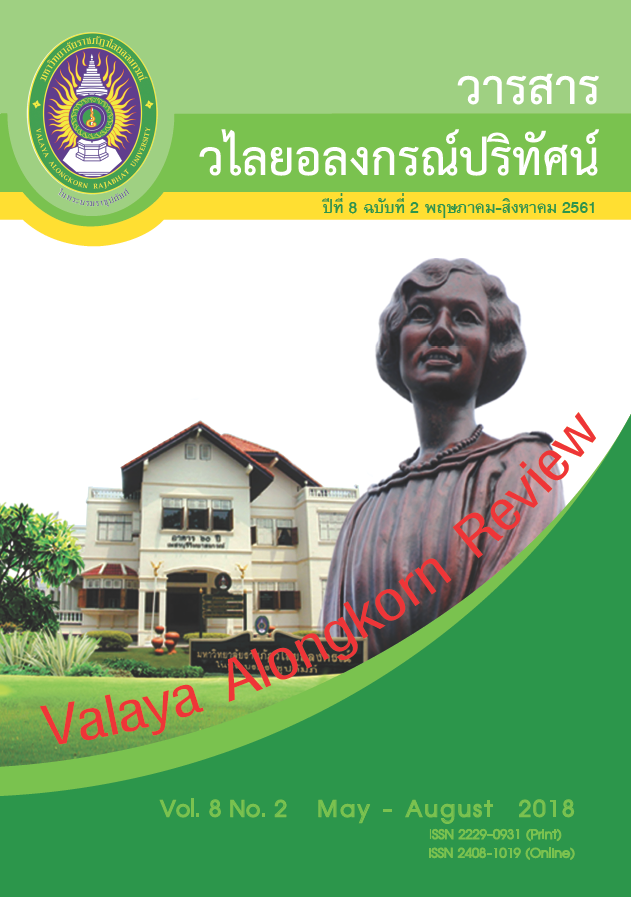รำมอญ: ความเป็นมาและการสืบทอดมรดกทางวัฒนธรรม ในจังหวัดปทุมธานี
คำสำคัญ:
รำมอญจังหวัดปทุมธานี, ความเป็นมา, การสืบทอดมรดกทางวัฒนธรรมบทคัดย่อ
วิจัยเรื่องนี้มีวัตถุประสงค์ เพื่อศึกษาความเป็นมาและการสืบทอดมรดกทางวัฒนธรรมของรำมอญในจังหวัดปทุมธานี วิธีการดำเนินการวิจัย ใช้วิธีวิจัยเชิงคุณภาพ โดยการศึกษา จากเอกสาร งานวิจัย หลักฐานทางโบราณคดี ประวัติศาสตร์ และข้อมูลภาคสนาม จากการสังเกต สัมภาษณ์ สนทนากลุ่ม ผู้ให้ข้อมูลมีจำนวนทั้งหมด 100 คน ประกอบด้วย กลุ่มผู้รู้ 20 คน กลุ่มผู้ปฏิบัติ 40 คน กลุ่มผู้ให้ข้อมูลทั่วไป 40 คน เครื่องมือที่ใช้ในการเก็บรวบรวมข้อมูล ได้แก่ แบบสังเกตแบบมีส่วนร่วม และไม่มีส่วนร่วม แบบสัมภาษณ์แบบมีโครงสร้าง และไม่มีโครงสร้าง และแบบสนทนากลุ่ม การตรวจสอบข้อมูลโดยการใช้เทคนิคการตรวจสอบแบบสามเส้า และนำเสนอผลการวิจัยโดยวิธีพรรณนาวิเคราะห์
ผลการวิจัยพบว่า ความเป็นมาและการสืบทอดมรดกทางวัฒนธรรมของรำมอญในจังหวัดปทุมธานี สันนิษฐานว่าน่าจะเริ่มจากการอพยพของชาวมอญที่หนีภัยสงครามตั้งแต่สมัยอยุธยา ก่อนรัชกาลของสมเด็จพระนารายณ์มหาราช พ.ศ. 2203 จนถึงสมัยรัตนโกสินทร์ จากเมือง เมาะตะมะและเมืองใกล้เคียง มาอยู่ที่สามโคก จังหวัดปทุมธานี ระหว่างที่อพยพเข้ามานั้นอาจจะมีนักแสดงเข้ามาด้วย เริ่มแรกจะแสดงเฉพาะในวัฒนธรรมประเพณีของชาวมอญ ภายหลังเป็นที่นิยมแพร่หลาย โดยเฉพาะประเพณีงานศพ เพราะชาวมอญมี ขนบ จารีต เกี่ยวกับความเชื่อว่าได้บุญ และถือว่าเป็นงานมงคลร่วมยินดีแก่ผู้ตายที่ได้ไปสู่สุขคติ ซึ่งรำมอญมีจารีต วัฒนธรรมของการรำ ที่มีการถ่ายทอดจากรุ่นสู่รุ่นโดยการจำ เริ่มแรกเป็นการถ่ายทอดจากครูมอญโดยตรง แต่ต่อมาสภาพแวดล้อม ขนบธรรมเนียม ประเพณี และค่านิยมเปลี่ยนไป จึงทำให้ผู้ที่ถ่ายทอดในรุ่นต่อ ๆ มาได้นำแนวคิดของตนมาผสมผสานสร้างสรรค์เพื่อให้สอดคล้องเกิดความสมบูรณ์ และสวยงามตามต้องการของสังคมและวัฒนธรรม
เอกสารอ้างอิง
ดุสิตธร งามยิ่ง. (2559). รำมอญ: ประเพณีทรงคุณค่าจังหวัดปทุมธานี. วารสารวไลยอลงกรณ์ปริทัศน์. 6(2): 57-66.
ทรงคุณ จันทจร. (2553). การวิจัยเชิงคุณภาพทางวัฒนธรรมขั้นสูง. มหาสารคาม: มหาวิทยาลัยมหาสารคาม.
ทองคำ พันนัทธี. (2524). ปทุมธานีในอดีต. ม.ป.ท.
นาฏยา สุวรรณทรัพย์. (2525). “การแสดงการละเล่นพื้นเมืองของจังหวัดปทุมธานี” สมโภช กรุงรัตนโกสินทร์ 200 ปี จังหวัดปทุมธานี. กรุงเทพฯ: โรงพิมพ์ส่วนท้องถิ่น กรมการปกครอง.
นาฏยา สุวรรณทรัพย์. (2557). สัมภาษณ์ รำมอญ. (2557, 20 มกราคม).
นิยพรรณ วรรณศิริ. (2540). มานุษยวิทยาสังคมและวัฒนธรรม. กรุงเทพฯ: คณะสังคมศาสตร์ มหาวิทยาลัยธรรมศาสตร์.
ประพัฒน์ กองศรี. (2557). สัมภาษณ์ รำมอญ. (2557, 3 ตุลาคม).
พงษ์สิริ ศิลปบรรเลง. (2540). การศึกษาเพลงรำมอญของเกาะเกร็ด จังหวัดนนทบุรี. กรุงเทพฯ: มหาวิทยาลัยศรีนครินทรวิโรฒ.
มรดกภูมิปัญญาทางวัฒนธรรม. (2557). วงปี่พาทย์มอญ. (Online). http://ich.culture.go.th. (2557, 30 ธันวาคม).
รจนา สุนทรานนท์. (2548). การอนุรักษ์การแสดงพื้นบ้าน จังหวัดปทุมธานี. คณะนาฏศิลป์และดุริยางค์ สถาบันเทคโนโลยีราชมงคล.
วัชรีย์ ทองชายเดช. (2557). สัมภาษณ์ รำมอญ. (2557, 2 ธันวาคม).
วิกิพีเดีย สารานุกรมเสรี. (2557). ชาวมอญ (Online). http://th.wikipedia.org., (2557, 15 ตุลาคม).
วีรวัฒน์ วงศ์ศุปไทย. (2551). อนุสรณ์งานพระราชทานเพลิงศพ ศาสตรจารย์เกรียติคุณ นายแพทย์สุเอ็ด คชเสนี. กรุงเทพฯ: เท็คโปรโมชั้น แอนด์ แอ็ดเวอร์ไทซิ่ง.
สุขสันต์ พ่วงกลัด. (2539). การวิเคราะห์เชิงประวัติศาสตร์เกี่ยวกับภูมิปัญญาไทยในการถ่ายทอดการบรรเลงซอสามสาย. วิทยานิพนธ์ครุศาสตรมหาบัณฑิต จุฬาลงกรณ์มหาวิทยาลัย.
องค์ บรรจุน. (2558). สัมภาษณ์ รำมอญ. (2558, 1 กุมภาพันธ์).
อนุมานราชธน. (2501). วัฒนธรรมเบื้องต้น. กรุงเทพฯ: ราชบัณฑิตยสถาน.
อมรา พงศาพิชญ์. (2537). วัฒนธรรม ศาสนา และชาติพันธุ์. กรุงเทพฯ: จุฬาลงกรณ์มหาวิทยาลัย.
ดาวน์โหลด
เผยแพร่แล้ว
รูปแบบการอ้างอิง
ฉบับ
ประเภทบทความ
สัญญาอนุญาต
ข้อความที่ปรากฏในบทความแต่ละเรื่องในวารสารวไลยอลงกรณ์ปริทัศน์ เป็นความคิดเห็นของผู้นิพนธ์แต่ละท่าน มิใช่เป็นทัศนะและมิใช่ความรับผิดชอบของกองบรรณาธิการจัดทำวารสาร และ
มหาวิทยาลัยราชภัฏวไลยอลงกรณ์ ในพระบรมราชูปถัมภ์


